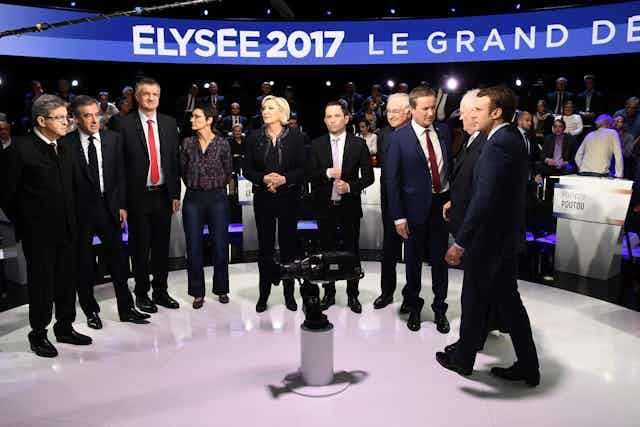With two weeks to go until the first round of the French presidential election, many people in France are stunned by the low quality of the campaign, which has been largely dominated by François Fillon’s legal saga. There has, to date, been very little in-depth discussion about actual policy.
Behind the judicial turmoils of some of the candidates, it is becoming increasingly clear that the campaign is about two significantly opposed visions of the future. One is declinist, supported by strategies of fear. The second is optimistic, promoting a strategy of opportunity.
Optimism versus anxiety
Three candidates claim they represent a majority of the French people, are haunted by a fear of French decline, and are deeply anxious about France’s role in an increasingly globalised world.
This approach of anxiety and threat perception is represented by Marine Le Pen, leader of the far-right National Front, Jean-Luc Mélenchon, candidate for the far-left movement Unsubmissive France, and François Fillon, for the conservative Republicans.
But, there is also a very different strategy, developed by Benoît Hamon, the Socialist Party candidate, and Emmanuel Macron, leader of En Marche! What’s remarkable is that both candidates promote a far more optimistic vision of opportunities for a better life and a better France.
Far-left Mélenchon and far-right Le Pen are diametrically opposed in many respects. However, Le Pen and Mélenchon share four similar diagnoses of the economic, identity and societal insecurities France is facing.
First, both Mélenchon and Le Pen base their strategies on anti-EU policies. They claim France’s economic independence requires a withdrawal from the eurozone, from the European Union’s treaties, and even – in Le Pen’s case – an exit from the EU as a whole.
Second, both leaders adhere to significant anti-globalisation policies. Le Pen and Mélenchon claim France’s economic difficulties come from its openness to the global market. Their remedy is protectionist policies.
A third common approach in narrative is that both play on the rejection of traditional elites and present themselves as anti-system.
This has been successful as a populist strategy, even though both belong to the system they loudly condemn – a trait observers of Donald Trump will recognise. Le Pen’s family is extremely wealthy and deeply connected to France’s aristocracy. Mélenchon was a minister in a former Socialist government.
A final similarity is that both claim to genuinely defend the working class and advance similar social policies – notably, to lower the pension age to 60.
These similarities partly attract the same electorate: the working class and the less-educated sections of society that have not benefited from globalisation.
However, the far-left has been associated with policy failure because Mélenchon has been in government in the past. Thus the strategy of fear mainly reinforces Le Pen’s popularity, rather than Mélenchon’s.
The current graphic representation of the far-right electorate in France tends to be an overlay of the traditional map of the communist and far-left electorate until the 1990s, when the Communist Party lost its appeal. According to a poll carried out in early March, 48% of the French working class now supports Le Pen’s program.
More broadly, both Le Pen and Mélenchon call for a return to an idealised – and historically inaccurate – past.
According to Le Pen, France’s salvation will come from going back to a traditional society that does not value any diversity, by implementing strict assimilation policies. For Mélenchon, the solution is a return to a protectionist economy that supports a strong working class.
The less-extreme candidates
Fillon is not as pessimistic as these extremes, although he does call for tough austerity measures – such as reducing the numbers of public servants by 500,000. He argues the French must tighten their belts for the next five years to avoid a situation like Greece.
What then of the two youngest candidates in the presidential election, who have developed their strategies with a distinctly optimistic tone?
Macron and Hamon, whose programs are significantly different, share a discourse around the politics of opportunity. Both candidates promote a strategy of welcome and acceptance when it comes to immigration and refugees.
At a time of continued crisis in the EU, both promote a significant deepening of EU integration. Hamon is in favour of strengthening the eurozone. And Macron has made the development of a genuine European army and diplomacy a priority.
Macron seems to have found a successful strategy – at least for now. His centrist approach has become very popular; he’s leading in the polls. What’s more, many politicians from the left and the centre have publicly supported Macron, as they calculate that En Marche! constitutes the most effective opposition to Le Pen.
However, Macron, like Hamon, struggles to convince many workers that a globalised economy offers benefits for them. Macron’s base is currently limited to the most-educated part of the population, which has been the main beneficiary of globalisation.
It is still difficult to predict who will be the next French president. The campaign has an increasingly populist dimension. All candidates have had to deal with a disaffection with established parties and political elites.
What’s clear is that the campaign has revealed narratives of two very distinctive Frances – one that perceives an ever-more globalised economy as a direct threat, and another that perceives challenges as opportunities.
After Brexit and Trump, will French voters put a halt to the declinist and populist wave sweeping other Western nations?
This article was co-published with Pursuit.

